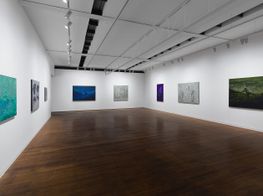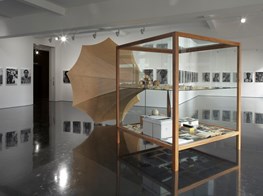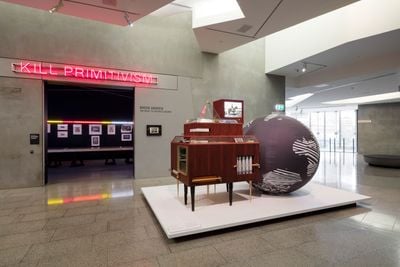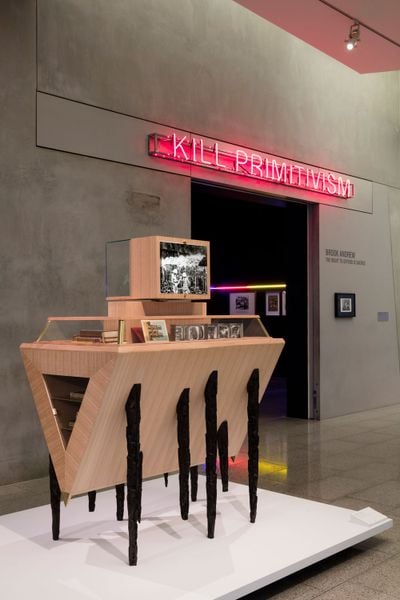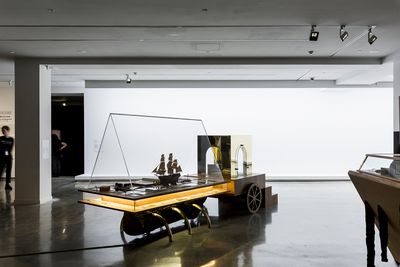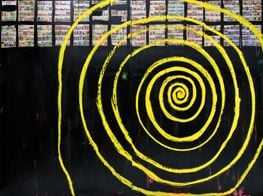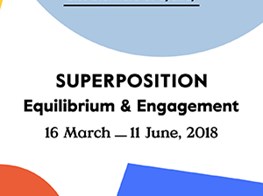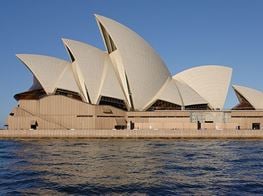Brook Andrew
In partnership with The 21st Biennale of Sydney
Brook Andrew and contributing artist Shiraz Bayjoo at the 21st Biennale of Sydney at the Art Gallery of New South Wales, Sydney. Courtesy 21st Biennale of Sydney. Photo: Zan Wimberley.

Brook Andrew and contributing artist Shiraz Bayjoo at the 21st Biennale of Sydney at the Art Gallery of New South Wales, Sydney. Courtesy 21st Biennale of Sydney. Photo: Zan Wimberley.
Australian artist Brook Andrew's practice often finds inspiration in institutional archives, but his intentions go beyond the archaeological: he is not primarily interested in discovering or documenting the past, but in 'un-cementing' history's hold on events, people and beliefs, and in doing so, freeing the discussions taking place today from that past. Andrew's art acknowledges that the writing and receiving of history are powerful acts, and in the discarding of alternate and 'other' versions there is a marginalisation and loss of those voices. His process is a necessarily subversive one—in his frequent mining of archives he is seeking to overturn mainstream historical narratives. He speaks of objects being 'released' from their ideologies and achieves this through manipulating their context and display. In his work What's Left Behind (2018) for the Biennale of Sydney (BoS) (16 March–11 June 2018), on show at the Museum of Contemporary Art Australia (MCA), he collaborates with four practitioners of various disciplines—Rushdi Anwar (Kurdistan/Melbourne), Shiraz Bayjoo (Mauritius/London/the Indian Ocean region), Mayun Kiki (Japan) and Vered Snear (Israel/USA)—to illustrate how memory and individual stories can imbue objects with meaning. Each of Andrew's 5 sculptural vitrines represent one of the elements of fire, water, metal, earth and air, and contain Andrew's and the four collaborators' own art works, along with objects sourced from the collection of Museum of Applied Arts and Sciences (MAAS), Sydney. The work asks the viewer to re-consider the information that is being presented and to ask questions about their own beliefs and views.
In a busy 2017 Andrew participated in a number of projects and exhibitions. He had a solo show at the National Gallery of Victoria (NGV), Brook Andrew: The Right to Offend is Sacred (3 March–4 June 2017), and took up a 'Deviant Practice' research grant at the Van Abbemuseum in Eindhoven. There he studied the institution's archives and modernist works from the museum's collection, re-sorting and re-categorising them, along with his own archive, culminating in the exhibition Ahy-kon-uh-klas-tik (15 September–31 December 2017), which, among other arrangements, saw Andrew place a painting by Picasso on its side. He also undertook a Smithsonian Artist Research Fellowship with the Smithsonian Institution, Washington DC, where he researched the National Anthropological Archives and Human Studies Film Archives in the Department of Anthropology with the aim of juxtaposing the complex portrayal and often misrepresentation of Indigenous peoples in film. Andrew is currently living in Berlin researching memorial sites in Europe as part of an Australia Council International Residency.
SACan you tell me about the work you are contributing for the 21st Biennale of Sydney (BoS)?
BAMy commission considers the idea of memory, that which is present but simultaneously absent, and how objects can have transferable and alternate realities and meanings. Titled What's Left Behind (2018), the intention is to imbue objects with their own or alternate histories and stories.
Having a shared interest in unpacking and making visible particular sites and histories, I've invited Rushdi Anwar, Shiraz Bayjoo, Mayun Kiki and Vered Snear to present an archive based on ideas related to 'what's left behind', but also to reflect on their own unique interests of research and practice. While this collaborative work will combine shared ideas and concerns regarding alternative and debated historical influences, it will also look at how we make work today and the deep connections between the artists and with the objects that are featured. These artists reveal alternate notions of political and cultural practices. For example, Mayun Kiki, is an Ainu linguist and musician who rekindles traditional Ainu tattooing, which was at various times banned by the Japanese. The Ainu are an indigenous group who lived in Hokkaido and were marginalised and then colonised by the Japanese.
We are presenting objects for five sculptures that challenge the long tradition of the museum vitrine. Entitled 'Tombs of Thought' and made from timber, glass, brass and light boxes, each of the five sculptures relate to one of the elements of water, air, fire, wood, earth and metal—a theme of BoS Artistic Director Mami Kataoka's that runs through the exhibition. The sculptures act as vessels for the display of objects, ephemera, books, postcards and films. Personal archives and objects from the project participants sit alongside items from the collection of the Museum of Applied Arts and Sciences (MAAS), Sydney. The installation aims to imbue a set of collection-based objects with their own or alternate histories and stories, serving as a release of the ideologies held within the objects. This installation also includes video works by the artists that show a deeper connection to the ideas behind the selection of objects and the installation as a whole.
SAArtistic Director Mami Kataoka's curatorial statement in part reads: 'The participating artists in the 21st Biennale of Sydney have been chosen to offer a panoramic view of how opposing understandings and interpretations can come together in a state of "equilibrium". My hope is that their artworks will serve as a catalyst for thinking about these principles and concerns, taking one's own position in society as a starting point.' Can your work be viewed through the prism of this idea?
BAI think Mami's idea of parallel positions is powerful. It reflects the existence of many familiar cultural stereotypes that reverberate globally but also are very present in the technological platform, in the way that stories are told. We only need to reflect on images of the wars in the Middle East, and how some countries censor particular scenes. I think it is a basic human dilemma that often the story being told is unconsciously one-sided. My practice has always been curious regarding non-dominant narratives. It is a trope to consider the 'other' side as incorrect or even dangerous and evil. The unknown often sparks ideas of fear and misleading assumptions, and maybe possible truths too. I used a strategy of presenting alternate histories or smashing together two opposing sides to tease out possible alternative interpretations.
SAIn this questioning, interpreting and re-interpreting of histories and historical relationships, your practice seeks to re-dress the balance of power by quizzing the status quo. Your work is subversive insofar as it questions received beliefs, but is it also morally directed? Do you look at the world through a moral lens or are you more interested in the intellectual ideas that result from such questioning—or both?
BAThis is a great question! A moral lens. My lens is constantly shifting and being challenged. I don't necessarily sit on the fence, as I have very firm ideas about some of my positions. For example, I do not believe that the world is a black and white paradigm, but I say this through an experience of loving both my parents, one of whom is Aboriginal and the other who has Celtic and Jewish ancestry. But I do understand why there is rage and division, because the world has been divided into slaves and conquerors and this still does affect and permeate current structures of ideology, and infuriates those (most of the world's population) who are left by the wayside as the remnants from the Enlightenment, colonisation, the Industrial Revolution and more recent revolutions continue to impact. The intellectual project that surrounds the moral is entwined with my practice and life values. The deep research and connections I have across both collecting institutes and communities is imperative. Various experiences have affected me: for example, the combination of a Smithsonian Artist Research Fellowship and my Australia Research Council project allowed an opportunity to forge meaningful connections with the descendants of the Sand Creek Massacre of 1864 in the USA. This combines with other stories that include the removal of Aboriginal ceremonial and burial trees of NSW from the early 1900s to the mid 20th century: items removed for various reasons, ranging from ethnographic study to 'preservation', from aiding land clearing to plain ignorance. Of 7,500 such trees, only around 100 remain in their original locations in NSW, with an additional few hidden in museums, rarely seen. Or the research conducted in three museums for my installation A Solid Memory of the Forgotten Plains of our Trash and Obsessions (2014) at Museo Nacional Centro de Arte Reina Sofía, Madrid, which was a comment on colonial Spanish/British/Australian connections to South America/Australia. Regardless of the historical context, the blending and intertwined frisson is a rolling stone of moral and intellectual experimentation and outing.
SAStanding by Tunnerminnerwait and Maulboyheenner (2016) is a public work that commemorates two Aboriginal men, Tunnerminnerwait and Maulboyheenner, who were convicted of the murder of two whale hunters in 1841 and hung in 1842. It is emblematic of the struggle for land during the Frontier Wars that saw frequent skirmishes between colonial and Indigenous Australia. In creating such a monument, what is your intent?
BAThe memorial is the result of more than a decade of political activism from the Tunnerminnerwait and Maulboyheenner working community group. They have been present on that site for a long time. It's been a difficult process for the community to have to deal with the fact that in their own country these devastating stories are not recognised by most of the population. So, you can imagine the relief of the group when, finally, the City of Melbourne got behind them and acknowledged this event! Trent Walter and I were part of a wider competition to undertake the memorial. I am grateful that the City of Melbourne had the integrity to acknowledge the invisible stories of our colonial past. It is this acknowledgement that heals. Imagine if you were part of a history that was not acknowledged. This has the capacity to drive you mad—or people think you are crazy—and this in itself is a psychological abuse that is real. The final design of the memorial is a garden with a bluestone headstone that also doubles as a metaphor for the seat of a swing. This reference to a children's playground is a very serious look at the way in which many Aboriginal and Torres Strait Islander (ATSI) histories are dismissed by mainstream narratives.
SAAt a time when the accepted singular narrative (and the idea of a linear history) has been fractured by the advent of social media, how do you think the making and dissemination of history and the 'truths' it seeks to tell are affected by this opening up of storytelling to a broader population? And what are the consequences for your practice?
BAA broader population who are in control of our own stories means the inclusion of those who are often ignored, looked down upon or dismissed, and these are often Indigenous and border cultures: now that's a radical idea. I've been watching Netflix's 'The Crown'; it's full of revealing fictional and non-fictional events. The intrigue for me is about letting that population affect the ruling class. And let's not forget that that ruling class, that doctrine, that colonial force is still represented on Australian dollar bills and coins. The consequences of questioning and disseminating alternate stories are problematic for the simple reason that modes of etiquette and class/cultural divisions are thrown in the bin. This causes eye rolling and intergenerational disruptions. Look at, for example, Sri Lanka or Mauritius, where the younger generations are breaking and pushing aside complex colonial ties that once bound the colonies to a state of class division and religious confusion. Australia is reflecting this. The consequences of any art form taking on this, whether it is music, film, poetry, dance, etcetera, is the same, just check out musicians Die Antwoord of South Africa or indeed Australian musician Archie Roach. They push back and clear a new space, new etiquettes. I suppose I aim for the same.
SAWhat is the role of the archive in your practice?
BAThe archive is important for me personally, as I grew up not knowing a lot about my mother's family. I knew where we are from, our place, but I am referring to the immense documentation of us as a people: our ancestors and other ATSI ancestors were photographed for scientific and touristic voyeurism. This painful documentation is no different to the recording of those being experimented on in the Nazi camps or to that that took place in Cambodia during the regime of Pol Pot in the 1970s or in the Dirty Wars in South America in the 1970s and 80s. Australia is still coming to terms with this level playing field of historical fact and knowledge about the violence of photography and alternate narratives—strongly labelled 'The History Wars'—and how these alternate truths are received is part of taking a long hard look at our 'national identity'. These photographic archives impacted me in my early days as a young artist and this is where I launched into an international comparative discourse. I suppose it's fair to say that the discovery of early ethnographic photographs of my mother's people, who are all unnamed, not to mention the immense number of photographs in international collections—this mess, as I call it—creates the ambition and complication of exposing other truths through the archive. For this reason, I collect mundane cartoons, magazines, sculptures and books, adding them to my growing personal archive, which I then juxtapose alongside museum archives and artworks.
Some museums are eager to share and challenge, such as the Van Abbemuseum project of 2017, where others could be more committed to challenging their own museological practices to adapt to a different mind-set, such as the Musée d'ethnographie de Genève. When it comes to the act of juxtaposition and challenge, this can be met with a heady mix of fierce ignorance, push-back and paternalism (a nightmare for the artist), but it does challenge me to find new ways of revealing the archive and making new work.
SAYou were awarded a Smithsonian Artist Research Fellowship in 2017. Can you tell me about the fellowship and other projects you are currently involved in?
BAThe Smithsonian Artist Research Fellowship was specifically looking at the international comparative studies of representation memorials of the Frontier Wars in Australia and the USA. This ongoing research is also part of the major three-year Australia Council Research project I have called Representation, Remembrance and the Memorial (RRM) (www.rr.memorial). This is an ambitious project connecting international sites of trauma to the Australia experience. The archive research at the Smithsonian focuses on photographic evidence of massacre and battlefield sites in the USA, of which they have ample visible material, in contrast to Australia.
Other research includes my current Australia Council Berlin residency that similarly involves deep research regarding the representation of the memorial and trauma sites here in Berlin and Europe generally. For my recent Van Abbemuseum project Ahy-kon-uh-klas-tik, part of curator Nick Aikens archival project 'Deviant Practice', I intervened with a number of key modernist works from their collection, including Pablo Picasso's painting Buste de Femme (1946), which I turned on its side, while Wilfredo Lam's Le Marchand D'oiseaux (1962) looked on in curious voyeurism at a 25-degree angle. I have a particular relationship with the mythology of Picasso and his engagement with cultures from the colonies.—[O]
–Presentation at the 21st Biennale of Sydney was made possible with generous support from Penelope Seidler AM and assistance from the Museum of Applied Arts and Sciences.

